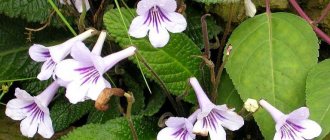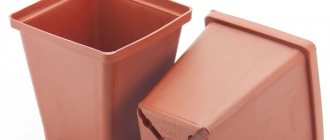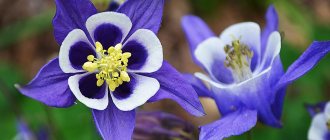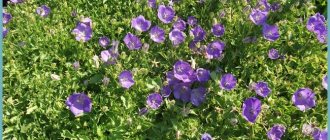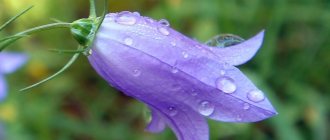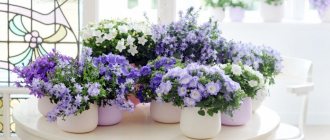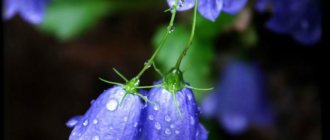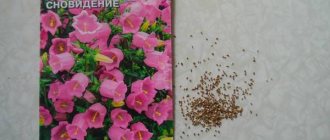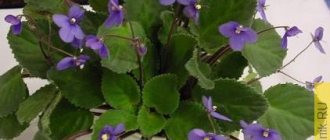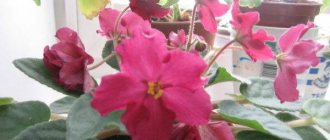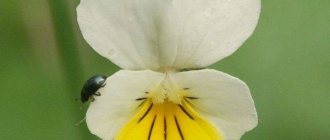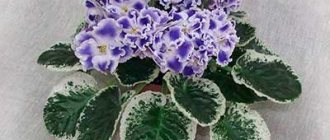Saintpaulias came to Europe from the tropical regions of East Africa. Most of their species grow naturally in the Usambara and Ulugur mountains of Tanzania and Kenya .
They are
called Uzambara or African violet:
- They prefer places shaded from the African sun. There is enough precipitation in these places all year round. Temperatures range from 13 to 30 degrees throughout the year. Quite hot in summer : On steep slopes and banks of streams and rivers;
- Waterfalls and ravines;
- In rock crevices.
Violets are called African or Uzambara violets.
- The flower he grew became noticeable at the exhibition within a year. In 1893;
Attention! There are not many species of them in nature. There are about 20 in total. Numerous hybrids surprise us.
Violet DS-Shining Bell
Among lovers of indoor violets, the variety is very popular and in demand.
What species does it belong to: genus, family
This variety belongs to the Gesneriaceae family Like the whole type of Saintpaulia.
Violet Shining bell belongs to the Gesneriaceae family.
Sauntpoulia ionanta Saintpaulia violetflower or Saintpaulia violetflower. You can see in the photo above DS-Shining bell how it looks and how it blooms.
History and author of the variety
How to achieve success when making flowers? Not only in growing original flowers. But also in the flower business. A serious question for many amateur gardeners. The Enikeev couple (Elena and Pavel) were able to do this:
Breeder Elena.
- We started out trading pears at the market. Where we met;
- The first violet could not withstand its diligent watering when leaving . There was not enough knowledge. And she died. Or maybe more because growing it was a burden rather than a joy;
- The passion for violets appeared a little later. My husband built a greenhouse... For orchids. Business did not work out for them. Profitability was not satisfactory;
- Violets came to the rescue. After purchasing cuttings of varietal violets via the Internet from breeders from Moscow. The first flower show gave a strong positive impulse;
Breeder Pavel. - We created a club of like-minded people, Dimetris. Not so long ago. New violets are more like experiments. Mostly with chimeras. But more begonias;
- And husband Pavel not only created several dozen varieties Streptocarpus. But he also wrote a book about them.
Pavel wrote a book about himself and Elena.
Here's the story. Appearance of the Shining Bell. From the Enikeev family.
Photo and description
Information about the variety of this Saintpaulia and its appearance is scant. And controversial. Much more is known about its creators and their passion for begonias and streptocarpus
- Standard socket. In many ways, its size and appearance depend on the conditions and efforts of lovers of this variety;
This variety has a standard outlet. - The leaves don't really attract attention. Quite large, with a smooth surface. They are a solid dark green color and oval in shape;
- Flowers look festive:
The variety has large flowers.Large wide bells. The unusually colored blue petals resemble a starry sky. With fancy splash strokes from the center;
- The edges are wavy with a white border;
- The core is light. As if illuminated;
- Its dimensions are about 6 cm in diameter.
Features and differences
This violet received an inappropriate name.
A very accurate and apt name . You can't confuse them with others. Flower growers notice that in some plants the blue color takes on purple hues. But just as shining.
What is sport in Saintpaulia Chimeras?
Violet macho: secrets of growing and propagating the prolific variety
Violet Raisin - description and characteristics of the variety
Chimeras include varietal violets that have stripes in the center of each petal. Sometimes the Shining Bell has blotches or streaks along the edges. There are various types of varieties, in which the inclusions may be darker or lighter in color.
What is sport among the Saintpaulia Chimeres?
There is a variegated chimera, which looks even more impressive thanks to its bright leaves, which only emphasize the beauty of the inflorescences.
Note! Chimera violets can produce baby sports that will turn out to be special and surpass the parent plant in beauty and originality. The violet never cross-pollinates, it just gives sport (blooms with sport)
Saintpaulia is prone to mutations, and their history of development is marked by many colorful examples. Quite often, a spontaneous mutation occurs, that is, it occurs spontaneously under normal environmental conditions.
The violet never cross-pollinates, it just gives sport (blooms with sport). Saintpaulia is prone to mutations, and their history of development is marked by many colorful examples. Quite often, a spontaneous mutation occurs, that is, it occurs spontaneously under normal environmental conditions.
The flowers of leaf chimeras are ordinary, without a contrasting stripe in the center of the petal, but with a unique pattern on the leaves. There are only a few such chimeras in the world, and growing them is not an easy but exciting task. Their leaves have little chlorophyll, they themselves are small in size, and the rosettes grow very slowly. If you root such a leaf, it will turn into a new plant with ordinary green leaves without a pattern.
Home care
This collection variety does not require any special conditions. As with most Saintpaulias.
Conditions of detention
Many gardeners achieve the promotional coloring of this variety . If optimal conditions have been created.
Deviations from such norms will be noticeable in the color of the flowers and the size of its rosette. And not only. This can also lead to illness.
Choose bright rooms and places . But without exposure to direct sunlight.
Proper watering and fertilizing
- The main nutrients of violets are obtained from water: It is the source of growth and flowering of violets. When used correctly;
- Consider the phases of plant development. And specific conditions. Both in the room and outside the window: Watering is necessary for the plant during the growing season and the formation of the rosette;
- From spring to autumn this should be done 2-3 times a week;
- Cut them back after flowering, when the violets are dormant. Even one a week may be enough.
Important! Use water for irrigation slightly warmer than room temperature. And defended.
- Water Saintpaulias only when necessary. When required: The soil is slightly dry on top;
- It needs to be kept slightly moist.
- Immerse the pot in prepared water. The soil itself picks up the required amount. Just like when watering in a tray. Be sure to remove excess from the pan when moistening the top layer of soil;
Lighting and temperature
Full lighting allows the Shining Bell to shine:
- In summer, this can be achieved without additional devices. On the windowsills. But in winter and far away apartments you can’t do without them;
- These flowers should not be exposed to the hot rays of the sun. They can lead to illness and death. For regulation and protection the following are used: Blinds (not plastic ones);
- Curtains;
- Parchment paper.
Important! Shaded conditions do not always provide the opportunity to create buds and bloom well. Elongation of the petioles also indicates insufficient light.
Air humidity
Dry air is not suitable for this violet .
It must be moistened during intensive operation of heating systems:
- Place the pots in trays with moistened sand and expanded clay;
- Spray the air near plants. But not the plants themselves;
- Place containers of water near the plants.
Priming
Well-prepared soil promotes full growth and beautiful flowering. It is advisable to have:
- Leaf soil;
- Sod land;
- High peat;
- Vermiculite;
- Charcoal;
- River sand (coarse);
- Sphagnum moss.
It will be easy for air to penetrate and allow moisture to pass through . Such soils are offered by specialized stores. In most cases, flower growers use them as a good basis for preparing their options.
The predominance of elements such as phosphorus and potassium is important during the formation of buds and flowering.
Primer for violets can be bought at a flower shop.
Important! The highest quality soil for Saintpaulia with watering and fertilizing is only enough for 9-12 months. It should not be improved, but replaced with a new one.
Pruning and hygiene
Many exhibition visitors pay attention to the beautiful rosette of this variety. It does not form on its own. It is necessary to cut in a timely manner:
- Faded flower stalks;
- Side sockets (stepchildren);
- Old lower leaves;
- Leaves are not growing properly. Or with a light suspicious color.
Reproduction methods
, rooting cuttings is more suitable for this variety And reproduction by children.
Seeds are preferred by specialists and those who like to experiment with new varieties.
When breeding, you can get a sport.
Beautiful sports can also . Like this.
Transplant rules, rejuvenation
- Each Saintpaulia lover has his own principles and rules for replanting his plants. They do this taking into account the condition of the violet and the soil;
- After its abundant flowering, many people do this. And someone in the spring: With a complete replacement of the soil;
- Remove dried and yellowed leaves with petioles;
- Inspect the roots and remove rotten and dry ones;
- Select a container according to the size of the outlet. It is optimal when they are 2-3 times smaller than the outlet;
- It may even require preventive treatments against diseases and pests. Including pots.
- Rooting of the apex during its elongation;
Important! Pay attention to drainage and substrate composition. Taking into account irrigation methods.
Difficulties in growing
The healthy and blooming appearance of plants indicates their well-being. If the plant is sick, this will immediately affect its appearance.
The most common diseases of Saintpaulia:
- Wilting of the bush - the lower leaves fade, the base of the shoot turns brown. This is a sign of the fungal disease late blight. In this case, the plant is difficult to save. You can water it with a solution of the “Bravo” preparation or try to root a healthy-looking leaf or the top of a rosette in another pot with light soil. Before planting, the cutting or rosette must be treated in a solution of the drug “Previkur”, in accordance with the manufacturer’s instructions, or the drug “Biosept” (at a concentration of 0.05%).
- Flowers and leaves turn brown - this is the development of the fungal disease Botrytis, or gray rot. The bush should be quickly isolated from others, cut off the infected leaves and sprayed twice a week with one of the preparations: Biosept, Euparen, Rovral or Captan.
- Vascular bacteriosis - the disease usually develops in rooms with very high air temperatures. Symptoms - the lower leaves of the violet are covered with mucus and soon die. Treatment is carried out with the drugs “Fundazol”, “Zircon”, “Immunocytophyte” or “Previkur”. It is also necessary to cool the air and improve ventilation in the room.
Pests of Saintpaulia:
- Thrips are dark, small insects. Symptoms - flower petals turn brown, dry out quickly, sometimes you can see dark moving dots on them - these are thrips. Soil insecticidal preparations in the form of sticks or tablets should be placed in the soil of each pot.
- Mites - after their attack, plant leaves become covered with red dots and thin cobwebs. The leaves become deformed and gradually die. Brown grooves appear on the cuttings. Young leaves in the center of the rosette may also be attacked, after which their shape becomes unnatural and the leaf blade becomes covered with yellow spots. The growth of Saintpaulia stops, the flower buds do not bloom, but become deformed. For treatment, you need to treat the bush twice with an acaricidal preparation, at weekly intervals.
- Nematodes are tiny worms that live in the soil. They have a depressing effect on the root system of plants, sucking juices from it. Their metabolic products are toxic to plants. Due to their small size, pests are difficult to notice. They can be seen visually only when replanting a flower and examining the roots. One of the signs of the presence of nematodes in the soil is the appearance of light green spots on the leaves, which darken and rot over time. Saintpaulias affected by nematodes grow poorly, weaken, do not bloom, become deformed and eventually die. It is almost impossible to destroy nematodes, so the flower along with the soil must be removed from the collection.
- Aphids are small green insects that feed on plant sap. They attack leaves, flower stems, buds and flowers. A whitish coating from aphid secretions appears on the leaves, the leaf blade becomes deformed, the plant loses its decorative effect and stops growing. Affected bushes are treated with Mospilan or Actellik.
Violet lovers will definitely like the flowers of the DS-Shining Bell variety. By providing these Saintpaulias with good care and favorable conditions for growth, their owners will be able to enjoy lush and long-lasting flowering almost throughout the year.
Features of flowering, growth and reproduction
This violet blooms beautifully. Everyone confirms this. Who saw her?
Development at home
Good conditions provide:
- Intensive leaf growth;
- Formation of a good rosette and buds.
Owners of this variety note that this happens faster than many other Saintpaulia varieties.
How long does it take to grow an adult plant?
It will take a lot of time to grow adult plants. It depends on many things. And concepts:
- Flower growers consider plants that are beginning to bloom to be mature;
- Where to start counting?
- From the moment of sowing the seeds - up to a year;
- From the beginning of rooting of the cuttings after 7-10 months.
And this bell bloomed even on an unseated baby . You can't call him an adult!
The variety blooms on unplanted plants.
How are varietal characteristics transmitted?
Your friends will also want to have this variety. If they see him at your place. It's not difficult to do:
- Rooting a cut leaf with a petiole: In water;
- In a peat tablet;
- Using sphagnum moss;
- In the ground.
Violets reproduce well by stepsons.
Specifics of flowering
Light core of small size. In the future it increases . This is clearly visible. If you compare only a blossoming flower with a long-blooming one. But the beauty remains! The flower is in a half-open state for a long time. Fully opens before wilting.
The white center of Saintpaulia becomes wider with each flowering.
What do flower stalks look like?
The rosette forms enough peduncles for good flowering . More than 3 bloom at the same time. Or maybe up to 10 pieces. Even though up to 3 flowers are formed on each of them.
Is it possible to achieve cap flowering?
Many buds on strong peduncles allow you to form a beautiful head. What many violet lovers strive for.
Violet has cap flowering.
Bud lifespan
Emerging and growing buds smoothly replace those that are already ending in bloom . And such beauty can delight your eye for a long time.
And the breaks between flowering are only 2-3 months.
Effect of high temperature
Temperature fluctuations are acceptable for growing and flowering Shining Bell. But the plant reacts in its own way to strong deviations. This is especially noticeable in the coloring.
Landing
Aquamarine violet: photo and description, features of growing at home
The roots of Saintpaulia are located in the upper layers of the earth, so shallow pots are suitable for planting. You need to select containers that are three times smaller than the outlet. This will ensure better flowering. To root the plant, a regular plastic cup will do.
The optimal growing temperature is considered to be 18-22 degrees Celsius. If the violet has to overwinter on the windowsill, you need to make sure that the soil does not become waterlogged - this will lead to death.
In summer, the plant must be protected from overheating in the heat. Violet is also afraid of drafts.
Saintpaulia prefers light sandy loam soils. You can purchase ready-made soil mixtures for violets or prepare the soil yourself. For this you will need:
- 4 components of turf;
- 1 compound peat;
- 1 part sand.
You can add humus and perlite.
Competent care means:
- correct watering;
- maintaining lighting;
- fertilizing
Violet Shining bell loves bright, diffused lighting. You should not place flower pots in a sunny direction, as this can lead to leaf burns. If the windows face south, shade the Saintpaulia. Lack or excess of lighting will affect the external condition of Saintpaulia.
With a lack of light, the leaves rush upward, cease to be velvety, and the plants rarely bloom. If the daylight hours are too long (more than 12-14 hours), the violet grows slowly, the leaves look down. To form a rosette, turn the pot. Remove dust from the plant with a soft brush or water.
Moist air is important for Saintpaulias, especially during the stages of obtaining seeds and propagating by cuttings. Therefore, they are placed in mini-greenhouses or covered with polyethylene. However, you cannot overdo it here, so as not to cause the development of fungal diseases.
When watering, there are several factors to consider:
- air temperature;
- soil composition;
- lighting;
- flower age;
- pot size;
- season.
You can water in different ways
If you choose to water from above, it is important to prevent water from getting on the leaves. Therefore, it is poured onto the edge of the pot, or you can use a small watering can
You can water it in the tray. To do this, place the pot in a basin with one-fourth of the water and wait until the soil is completely moistened. You should not place several plants in a tray at once to prevent infection with diseases.
Wick irrigation is characterized by the fact that water is supplied using twine dipped in an aqueous solution with fertilizers. This option is preferable when the owner is away for a long time.
In winter, the water in the soil cools quickly, which is harmful to the roots.
Therefore, it is important to heat the water to room temperature and also let it sit for 24 hours
During the warm season, Saintpaulias are fertilized twice a month. At the same time, mineral fertilizers and organic matter alternate. After planting, the plant is not fertilized for two months. Before fertilizing, water the soil; this will help protect the root system from burns. If a violet grows under artificial lighting, it needs feeding throughout the year.
Reviews
Ivan Leonidovich. “The name of the variety doesn’t always mean anything. And here you don’t even need to think. Surprisingly appropriate. The light, even luminous middle is impressive. And such an incomparable contrast of white and blue. She's still growing.
The variety in question attracts many violet lovers.
Its size increases with flowering time. In size it doesn't even reach the standard size. But this is the first flowering. I think she'll get some good size."
Allah. “We need to keep an eye on the outlet. So that it doesn't fall apart. Leaves may stretch out. As well as the temperature. At low levels, white begins to simply reign.”
Diseases and pests of the variety
Each owner of such Saintpaulia strives to prevent its disease. And get rid of any pests. And there are many of them!
The most dangerous diseases are fungal ones:
- Gray rot;
- Late blight.
Considerable harm can be caused by:
- Thrips;
- Aphid;
- Ticks;
- Nematodes.
What conditions contribute to the emergence and spread of diseases?
These uninvited and unwanted guests may appear with your participation. As well as the fact that their elimination depends on you. If you detect them in a timely manner and take appropriate measures:
- Incorrect watering. Excessive watering at low temperatures is especially dangerous;
- Burning direct sunlight;
- Acquisition of affected new specimens;
- Critically low temperatures and drafts;
- Untimely replacement of already outdated soil.
Preventive measures at home
Create the right conditions for growing Shining Bell. This is the main thing:
- Carry out systematic treatments against diseases and pests. Use reliable tools. Both purchased in stores and simple folk ones;
- Carefully inspect new specimens you purchase for the presence of sores and pests. Provide them with mandatory quarantine and processing upon delivery home;
- Do not bring or leave garden and forest bouquets in the apartment. No matter how beautiful they are!
How to replant a plant
DS Shining bell needs a separate pot; spring is the best time to replant it in new soil. After laying a drainage layer of pieces of expanded clay or broken ceramics at the bottom, the substrate is poured. Planting in a pot that is too large can stop flowering, so some crowding is even welcome. The material of the pot can be either ceramic or plastic. Before replanting, it is better to cover the bush with a bag to prevent soil from getting in.
How to transplant correctly
